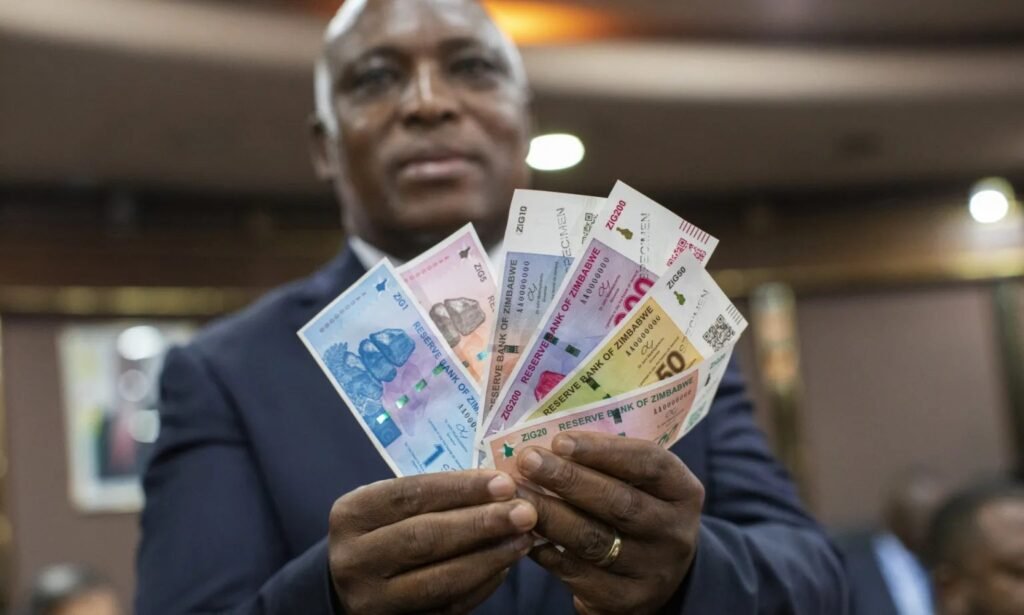The Reserve Bank of Zimbabwe (RBZ) has reported a notable rise in the use of the Zimbabwe Gold (ZiG) currency, with uptake increasing by 14 percentage points in just over a year. According to the central bank’s latest data, the proportion of transactions conducted in ZiG grew from 26% in April 2024 — when the currency was launched — to 40% by June 2025.
RBZ Governor Dr. John Mushayavanhu described the development as a sign of “improving macroeconomic stability” in the 2025 Mid-Term Monetary Policy Statement released this week. “The proportion of electronic ZiG in the National Payments System rose from 26% in April 2024 to over 40% in June 2025,” Mushayavanhu said, noting that demand for ZiG cash had also risen.
The bank has set clear targets for increasing physical currency circulation, directing commercial banks to ensure that at least 3% of their ZiG deposits are held in cash form, a benchmark in line with regional norms. In addition, all banks must have ZiG available via automated teller machines (ATMs) by the end of September 2025. The RBZ says more than ZiG200 million is already in bank vaults awaiting distribution, and new, redesigned banknotes are in the advanced stages of production.
While the RBZ points to the uptake as a sign of growing confidence, Zimbabwe’s monetary history casts a long shadow over the ZiG’s prospects. Currency volatility and public distrust have plagued the country for over two decades, eroding faith in locally issued money.
The economic turbulence began in the early 2000s, when land reform disruptions, shrinking industrial output, and economic mismanagement triggered hyperinflation. By late 2008, annual inflation had reached an astronomical level, rendering the Zimbabwe dollar effectively worthless. The government abandoned it in early 2009 in favour of a multicurrency system dominated by the US dollar, which brought temporary stability.
The local currency re-emerged in 2016 in the form of bond notes, initially pegged at 1:1 with the US dollar. But the peg collapsed under market pressure, and by 2019, the RBZ reintroduced the Zimbabwe dollar (ZWL) as sole legal tender while banning foreign currency transactions. This move was quickly undermined by soaring inflation driven by excessive money printing, fiscal deficits, and exchange rate controls. By 2022, the ZWL had been almost completely displaced in daily transactions, and the economy reverted to heavy dollarisation.
RBZ Reports Surge in ZiG Usage, but Trust Issues Persist
Against this backdrop, the ZiG was launched on 5 April 2024 as a gold-backed currency intended to restore monetary stability. The RBZ marketed it as a durable alternative, promising that its value would be underpinned by the country’s gold reserves and other precious minerals. However, the rollout faced immediate challenges. Public scepticism was high, physical cash availability was limited, and the US dollar retained its dominance in most retail and wholesale markets. For many Zimbabweans, memories of forced conversions of US dollar accounts into local currency balances — most recently in 2019 — remain fresh.
Mushayavanhu insists that the ZiG is gaining traction because of “tight monetary discipline” and the currency’s asset backing. The RBZ has maintained strict control over its exchange rate, supported by interest rate measures and limits on money supply growth.Despite these efforts, the ZiG’s stability remains fragile. Economists caution that its current value is being sustained by administrative controls rather than organic market confidence. They warn that loosening these controls — as has happened in previous currency experiments — could trigger sudden depreciation.
The RBZ has stated its ambition to phase out the multicurrency system entirely by 2030, making the ZiG the sole legal tender. While the government sees this as a necessary step towards full monetary sovereignty, the plan has alarmed business leaders, trade unions, and civil society groups. Many have demanded a detailed de-dollarisation roadmap, explicit guarantees that US dollar bank balances will be protected, and assurances that USD-denominated contracts will remain enforceable after 2030.
Analysts agree that the key to the ZiG’s survival lies not just in central bank policies but in broader structural reforms. These include credible fiscal management, transparency in reserve holdings, and policy consistency. Without such measures, they warn, the ZiG risks repeating the trajectory of the Zimbabwe dollar, bond notes, and other short-lived currency experiments.
“Currency stability is about more than numbers in a report,” one Harare-based economist told this publication. “It’s about whether people believe that the rules won’t change overnight, that their savings are safe, and that the government won’t resort to printing money to cover its expenses.”
For now, the RBZ is highlighting the growth in ZiG usage as evidence of a turning point. But in a country where official optimism has often preceded renewed crisis, the public remains cautious. Whether the ZiG becomes a lasting foundation for Zimbabwe’s economy or another chapter in its turbulent monetary history will depend on whether the central bank can turn technical progress into genuine trust.
Source- ZimEye







